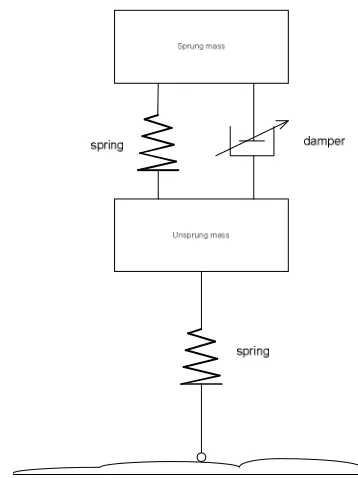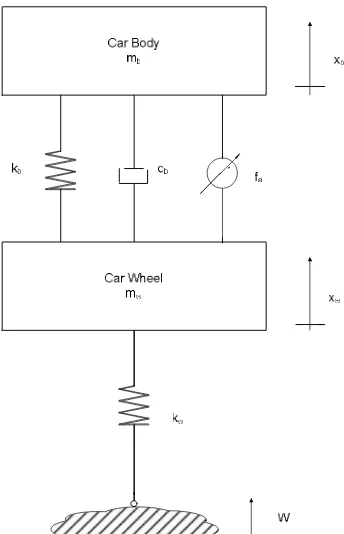ACTIVE SUSPENSION SYSTEM WITH FUZZY LOGIC CONTROLLER
ZATUL IFFAH BINTI AHMAD
This report is submitted in partial fulfillment on the requirements for the award of Bachelor of
Electronic Engineering (Computer Engineering)
Faculty of Electronic and Computer Engineering
Universiti Teknikal Malaysia Melaka
UNIVERSTI TEKNIKAL MALAYSIA MELAKA
FAKULTI KEJURUTERAAN ELEKTRONIK DAN KEJURUTERAAN KOMPUTER
BORANG PENGESAHAN STATUS LAPORAN
PROJEK SARJANA MUDA II
Tajuk Projek : ACTIVE SUSPENSION SYSTEM WITH FUZZY LOGIC CONTROLLER Sesi
Pengajian : 0 9 / 1 0
Saya ………ZATUL IFFAH BT AHMAD……….. (HURUF BESAR)
mengaku membenarkan Laporan Projek Sarjana Muda ini disimpan di Perpustakaan dengan syarat-syarat kegunaan seperti berikut:
1. Laporan adalah hakmilik Universiti Teknikal Malaysia Melaka.
2. Perpustakaan dibenarkan membuat salinan untuk tujuan pengajian sahaja.
3. Perpustakaan dibenarkan membuat salinan laporan ini sebagai bahan pertukaran antara institusi
pengajian tinggi.
4. Sila tandakan ( √ ) :
SULIT*
*(Mengandungi maklumat yang berdarjah keselamatan atau kepentingan Malaysia seperti yang termaktub di dalam AKTA RAHSIA RASMI 1972)
TERHAD** **(Mengandungi maklumat terhad yang telah ditentukan oleh
organisasi/badan di mana penyelidikan dijalankan)
TIDAK TERHAD
Disahkan oleh:
__________________________ ___________________________________
(TANDATANGAN PENULIS) (COP DAN TANDATANGAN PENYELIA)
iv
“I hereby declare that this report is the result of my own work except for quotes as cited in the references”
Signature : ………
Author : ………
“I hereby declare that I have read this report and in my opinion this report is sufficient in terms of the scope and quality for the award of Bachelor of Electronic Engineering
(Computer Engineering) with honours.”
Signature : ………
Supervisor’s Name : ………
Date : ………
vi
DEDICATION
Special dedication to my beloved father and mother, my brother and sister, and my kind
vii
ACKNOWLEDGEMENT
In the name of ALLAH SWT, the most gracious, who gave me the strength and
ability to complete this study. All perfect praises belong to ALLAH SWT, lord of the
universe. May His blessing upon the prophet Muhammad SAW and member of this family
and companies.
I gratefully acknowledge the co-operation of Mr. Amat Amir Bin Basari who has
provided me with the reference, guidance, encouragement and support in completing this
thesis. All the regular discussion sessions that we had throughout the period of study have
contributed to the completion of this project.
Thank you to my classmate for providing an enjoyable study environment. Finally, I
viii
ABSTRACT
Suspension system design plays an important role in improving passenger ride
comfort. Traditionally automotive suspension designs have been a compromise between the
two conflicting criteria of suspension travel and road handling ability. Demand for better ride
comfort and good car handling have motivated researchers to develop new type of suspension
systems. Road holding ability is associated with the contact forces of the tires and the road
surface. These contact forces are assumed to depend linearly on the tire deflection.
Suspension travels refers to the relative displacement between the sprung and unsprung
masses. The present work aims at developing an active suspension system for the quarter car
model of a passenger car to improve its performance by using a Fuzzy Logic Controller. To
verify the performance of the active suspension system we simulate it using MATLAB and
ix
ABSTRAK
Sistem suspensi memainkan peranan penting dalam memperbaiki keselesaan
perjalanan penumpang. Secara tradisionalnya, rekabentuk sistem suspensi automotif telah
dipengaruhi oleh dua faktor penting dalam memenuhi keselesaan penumpang. Permintaan
yang tinggi dalam keselesaan dan pengawalan sesuatu kenderaan telah membuka minda
untuk mencipta sistem suspensi yang lebih baik seperti sistem suspensi aktif. Suspensi aktif
menggunakan elektrik untuk pemantauan keadaan kereta, digabungkan dengan sesuatu
pengawal untuk mengawal pergerakan kereta dengan lebih baik. Bagi perojek ini, ia
menekankan tentang rekabentuk model suspensi kereta yang berfungsi dengan satu tayar
untuk menambah baik prestasi dengan menggunakan kawalan Fuzzy logic. Untuk
membuktikan prestasi sistem aktif suspensi ini kami simulasi model ini di dalam MATLAB
serta membuat perbandingan antara aktif suspensi dengan sistem suspensi pasif serta suspensi
1
CHAPTER I
INTRODUCTION
1.1. Suspension System
When designing vehicle suspension system, the objectives are to minimize the vertical
forces transmitted to the passengers for passenger comfort, to minimize suspension travel and
to maximize the tire-to-road contact for road handling and safety [1]. Generally a vehicle
suspension system may be categorized as either passive, semi active or fully active systems.
Passive suspension system includes the conventional springs and shock absorbers used in
most cars as shown in Figure 1.1. The springs are assumed to have almost linear
characteristics while most of the shock absorbers exhibit nonlinear relationship between force
and velocity. In passive system, these elements have fixed characteristics and, hence, have no
mechanism for feedback control. When the suspension system must operate over a wide
range of conditions, there should be a compromise in choosing the spring stiffness and
damping parameters. In other words, it is desirable that the above parameters could be
2
Figure 1.1: Passive Suspension System
Semi active suspension system provides control real-time dissipation of energy. For
an automotive suspension this is achieved through a mechanical device called active damper,
which is used in parallel with a conventional spring as shown in Figure 1.2. The main
advantage of this system is to adjust the damping of the suspension system, without any use
of actuators. This type of system requires some form of measuring devices with a controller
3
Figure 1.2: Semi-active Suspension System
The demand of better ride comfort and controllability of road vehicles has motivated
many automotive industries to consider the use of active suspension. Active suspension
employs pneumatic or hydraulic actuators which in turn creates the desired force in
suspension system as shown in Figure 1.3. The actuator is secured in parallel with spring and
shock absorber. Active suspension requires 2 accelerometers that mounted at sprung and
unsprung mass, and a unit of displacement transducer to measure the motions of the body,
suspension system and unsprung mass. This information is used by the online controller to
command the actuator in order to provide the optimum target force. Active suspension may
consume large amounts of energy in providing the control force. Therefore, in the active
suspension system the power consumptions of actuator should also be considered as an
important factor. In analysis of suspension system, there are variaties of performance criteria
which need to be optimized. There are three performances criteria which should be
considered carefully in designing a suspension system; namely body acceleration, suspension
travel and wheel deflection. The performance of the system can be further improved by
4
5
1.2. Active Suspension System Control Strategies
The objective of the active suspension system is to improve the suspension system
performance by directly controlled the suspension forces to suit with the performance
characteristics. There is various linear control strategies have been established by
previous researchers in the design of the active suspension system. Amongst them are a
fuzzy reasoning, robust linear control, andH∞ .
1.3. Objective of Study
The objectives of this project are as follows:
I. To develop the mathematical model of quarter car passive suspension system.
II. To develop the mathematical model of active suspension system.
III.To develop the fuzzy logic control strategy for the system.
IV.To simulate and control the active suspension system.
The performance of the active suspension system will be observed by using extensive
computer simulation that will be performed using MATLAB software and SIMULINK
Toolbox subjected to various types of road profiles and parameter value.
1.4. Problem Statement
The main function of vehicle suspension system is to provide effective isolation from
road surface unevenness, stability and directional control during handling maneuvers
without loss of ride comfort and vehicle support. Traditional vehicle suspension systems
are composed of two parallel components which are spring and dampers. Suspension
system designers are faced with the problem of determining suspension spring and
damper coefficients. Two important factors conflicting with each other must be
6
1.5. Scope of Work
The scopes of work for this study are as follows:
I. Familiarization of a quarter car active and passive suspension system.
II. Mathematical derivation of quarter car active and passive suspension system.
III.Design fuzzy logic controller for the active suspension system.
IV.Perform a simulation works for the passive and active suspension system in
MATLAB/Simulink.
V. Compare the performance of passive and active suspension system with fuzzy
This project will involve four phases of work:
i) First Phase : Literature Review
ii) Second Phase : Design and Simulation
iii)Third Phase : Implementation
iv)Fourth Phase : Thesis Writing
i) First Phase : Literature Review
Information gathering about the project via internet, journals, magazines, published work and reference books.
Study of the software implementation (Simulink, Matlab).
Make research to know more detail about active and passive suspension system and Matlab.
ii) Second Phase: Design and Simulation
7
The state space representation of the dynamic model for both active and passive suspension system is outlined.
The various road profiles that represent the uncertainty will be used as the disturbance to evaluate the performance of the designed controller.
Use MATLAB/Simulink software to simulate passive and active suspension system.
iii)Third Phase : Implementation
The simulation results will be observed and presented.
iv) Fourth Phase: Thesis writing
State all the ideas concentrated regarding to this project.
Show flow of ideas during the implementation of this project.
State the project conditions (from the beginning until the end of the project).
Details explanation of the project methodology will be explained in Chapter III
8
1.6. Structure and Layout of Thesis
Summarization of each chapter included in the report:
i) Chapter 1 : Introduction
ii) Chapter 2 : Literature Review
iii) Chapter 3 : Project Methodology
iv) Chapter 4 : Results and Discussion
v) Chapter 5 : Conclusion and Recommendation
i) Chapter 1: Introduction
This first chapter is more on the general overview of the project. In this
chapter, the background of the problem and the emergence of the project are stated
first. Besides, the project objectives, scope of project and the methods used are also
included.
ii) Chapter 2: Literature Review
This second chapter discusses the background of study related to the project.
This chapter consists of the evidence with the broad (e.g. books, internet, lecture notes
etc) and focus (previous PSM, thesis, journal papers etc) areas of the study. In this
chapter, the trend, direction and research issues are also identified. It can be said that
this chapter is more on the evidence of not repeating what others have done.
iii) Chapter 3: Project Methodology
In project methodology, the materials, subjects, and equipment or apparatus
9
implementation are also stated. Insufficient, the justification for choosing the method
or approach is also stated.
iv) Chapter 4: Results and Discussion
In this chapter, the observation and result obtained from the data analysis are
presented. Then, the project discovery is arranged tidily using the aid of figures and
tables. Besides, the result or discovery is explained and compared with previous
studies. Then, the result from the comparison is discussed.
vi) Chapter 5: Conclusion and Recommendation
The conclusion part is about the summarization of main findings of the
projects. A brief recommendation for future study is stated at the recommendation


